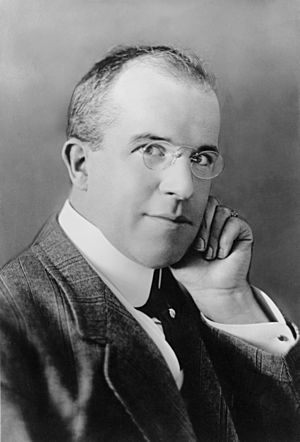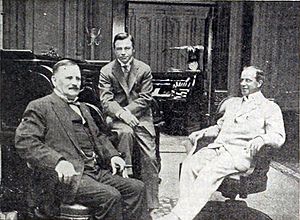J. Stuart Blackton facts for kids
Quick facts for kids
James Stuart Blackton
|
|
|---|---|

Blackton in 1912
|
|
| Born |
James Stuart Blacktin
January 5, 1875 Sheffield, England
|
| Died | August 13, 1941 (aged 66) Los Angeles, California, U.S.
|
| Known for | Vitagraph Studios |
| Spouse(s) | Isabelle MacArthur (m. 1897; div. 1906) Paula Hilburn (m. 1908–1930; her death) Rachel Helen Stahl (m. 1931–1933; her death) Evangeline Russell (m. 1936) |
| Children | 4, including Marian Constance Blackton |
| Relatives | Cornell Woolrich (son-in-law) |
James Stuart Blackton (born January 5, 1875 – died August 13, 1941) was a British-American film producer and director. He worked during the time of silent films, before movies had sound. He was one of the very first people to make movies.
In 1897, he started a company called Vitagraph Studios. Blackton was also one of the first to use special tricks like stop-motion and drawn animation in his films. Because of this, many people call him a father of American animation. He also helped bring many classic plays and books to the big screen for the first time.
Contents
Biography: The Life of a Film Pioneer
James Stuart Blackton was born in Sheffield, England, on January 5, 1875. His parents were Henry Blacktin and Jessie Stuart. In 1885, his family moved to the United States. They changed their last name to Blackton.
Blackton worked as a reporter and artist for a newspaper called the New York Evening World. He also performed on stage with a magician named Albert Smith.
Meeting Thomas Edison
In 1896, the famous inventor Thomas Edison showed off his new Vitascope. This was one of the first machines that could project movies. Blackton was sent to interview Edison and draw pictures of how his films were made.
Edison was happy to get good publicity. He took Blackton to his special filming studio, called the Black Maria. There, Edison filmed Blackton quickly drawing a picture of him. Edison was very good at explaining how movies were made. He convinced Blackton and his partner, Albert Smith, to buy a copy of the new film. They also bought nine other films and a Vitascope projector.

Their new show was a big hit! Blackton and Smith then decided to start making their own films. This is how the American Vitagraph Company began.
J. Stuart Blackton was in charge of the Vitagraph studio. He produced, directed, and wrote many of its films. He even acted in some of them. For example, he played the cartoon character "Happy Hooligan" in a series of short films. Since the company was making more and more money, Blackton felt free to try out any new idea. This led him to develop new ways of making animated films.
Animated Films: Bringing Drawings to Life
Blackton's first animation film was The Enchanted Drawing. It was likely made around 1899, though it was copyrighted in 1900. In this film, Blackton draws a face, a bottle of wine, a glass, a top hat, and a cigar. During the film, he seems to pull the wine, glass, hat, and cigar out of the drawing as real objects. The face he drew also seems to react to what's happening.
This "animation" used a technique called stop-action. This is where the camera is stopped, a small change is made, and then the camera is started again. This process was first used by other filmmakers like Georges Méliès.
The idea for stop-motion animation came about by accident around 1905. One day, Blackton's crew was filming outside. Steam from a generator was blowing in the background. When they watched the film, they saw the steam puffs moving strangely across the screen. They decided to try and create this effect on purpose. Some early films used this trick to show invisible ghosts or toys coming to life.
In 1906, Blackton directed Humorous Phases of Funny Faces. This film used stop-motion and even stick puppets. Blackton draws two faces on a chalkboard. They then seem to come alive and do funny things. Most of the film used live-action effects, but it still greatly influenced how animated films were made in America.
In Europe, another of Blackton's films, The Haunted Hotel (1907), had a similar effect. The Haunted Hotel was mostly live-action. It was about a tourist staying in an inn run by invisible spirits. Many of the special effects were done with wires. However, one scene showed a dinner making itself using stop-motion. This part was filmed very close up, so new animators could study how it was done.
Blackton made another animated film that still exists, Lightning Sketches (1907). By 1909, Blackton was too busy running Vitagraph to make many films himself. He thought his animation experiments were just for fun and didn't mention them much later in his life.
Later Life and Other Films
J. Stuart Blackton believed the United States should join the Allies in World War I. In 1915, he made a film called The Battle Cry of Peace. Former President Theodore Roosevelt strongly supported this film. He even convinced a general to lend Blackton a whole group of marines to act in the movie. When the film came out, it caused a lot of discussion. Some people saw it as promoting war.
Blackton left Vitagraph in 1917 to work on his own films. But he came back in 1923 to work with Albert Smith again. In 1925, Smith sold the company to Warner Brothers for over a million dollars.
Blackton did well with his share of the money for a while. However, he lost most of his savings during the Stock Market Crash of 1929. He went bankrupt in 1931. In his last years, he traveled around. He showed his old films and gave talks about the early days of silent movies.
He married actress Evangeline Russell in 1936.
Blackton died on August 13, 1941. This was a few days after he was hit by a car while crossing the street with his son. At the time of his death, he was working on new ways to improve color in films. Blackton was buried at Forest Lawn Memorial Park Cemetery in Glendale, California.
Select Filmography
| Year | Title | Notes |
|---|---|---|
| 1898 | The Burglar on the Roof | Short film |
| 1898 | Tearing Down the Spanish Flag | Short film |
| 1898 | The Humpty Dumpty Circus | Short film |
| 1900 | The Enchanted Drawing | Short film |
| 1902 | The Twentieth Century Tramp; or, Happy Hooligan and His Airship | Short film |
| 1905 | The Adventures of Sherlock Holmes; or, Held for Ransom | Short film |
| 1906 | Humorous Phases of Funny Faces | Short film |
| 1906 | The Automobile Thieves | Short film |
| 1907 | A Curious Dream | Short film |
| 1907 | The Haunted Hotel | Short film |
| 1907 | Lightning Sketches | Short film |
| 1908 | The Thieving Hand | Short film |
| 1908 | Macbeth | Short film |
| 1908 | Romeo and Juliet | Short film |
| 1908 | The Airship, or 100 Years Hence | Short film |
| 1908 | Antony and Cleopatra | Short film |
| 1909 | The Bride of Lammermoor | Short film |
| 1909 | Oliver Twist | Short film |
| 1909 | Princess Nicotine; or, The Smoke Fairy | Short film |
| 1909 | Les Misérables | |
| 1909 | Napoleon, the Man of Destiny | |
| 1909 | A Midsummer Night's Dream | Short film |
| 1909 | The Life of Moses | |
| 1911 | Ivanhoe | |
| 1911 | Lady Godiva | Short film |
| 1911 | A Tale of Two Cities | |
| 1912 | Richard III | |
| 1912 | Cardinal Wolsey | |
| 1915 | The Battle Cry of Peace | |
| 1915 | Crooky | |
| 1916 | Whom the Gods Destroy | |
| 1917 | The Judgment House | |
| 1917 | Womanhood, the Glory of the Nation | |
| 1917 | The Message of the Mouse | |
| 1918 | Life's Greatest Problem | |
| 1918 | The World for Sale | |
| 1918 | Wild Youth | |
| 1919 | The Common Cause | |
| 1920 | My Husband's Other Wife | |
| 1920 | Passers By | |
| 1920 | The Forbidden Valley | |
| 1920 | Man and His Woman | |
| 1920 | The House of the Tolling Bell | |
| 1922 | The Glorious Adventure | |
| 1922 | A Gipsy Cavalier | |
| 1923 | The Virgin Queen | |
| 1923 | On the Banks of the Wabash | |
| 1924 | Between Friends | |
| 1924 | Let Not Man Put Asunder | |
| 1924 | The Beloved Brute | |
| 1924 | Behold This Woman | |
| 1924 | The Clean Heart | |
| 1925 | The Happy Warrior | |
| 1925 | The Redeeming Sin | |
| 1925 | Tides of Passion | |
| 1926 | Bride of the Storm | |
| 1926 | Hell-Bent for Heaven | |
| 1926 | The Gilded Highway | |
| 1926 | The Passionate Quest | |
| 1927 | The American | |
| 1934 | The Film Parade |
Archives
Blackton's film The Film Parade was fixed up by the UCLA Film and Television Archive in 2009. The Academy Film Archive also saved Blackton's 1910 film A Modern Cinderella in 2012.




